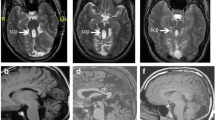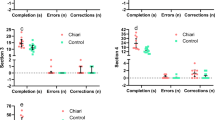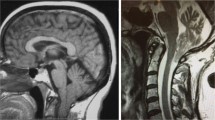Abstract
The neuropsychological characteristics of the cerebellar cognitive affective syndrome (CCAS) in congenital, non-progressive malformations of the cerebellum have been scarcely investigated, and even less is known for Joubert syndrome (JS), an inherited, non-progressive cerebellar ataxia characterized by the so-called molar tooth sign. The few studies on this topic reported inconsistent results about intellectual functioning and specific neuropsychological impairments. The aim of this research is to examine the neuropsychological profile of JS compared to other congenital cerebellar malformations (CM), considering individual variability of intellectual quotient (IQ) in the two groups. Fourteen patients with JS and 15 patients with CM aged 6-25 years were tested through a comprehensive, standardized neuropsychological battery. Their scores in the neuropsychological domains were inspected through descriptive analysis and compared by mean of MANOVA and ANOVA models, then replicated inserting IQ as covariate. The two groups showed a largely overlapping neuropsychological profile, consistent with CCAS. However, the JS group showed worse performance in visual-spatial memory compared to CM patients, although this difference was mitigated when considering IQ. These findings highlight a divergence between JS and other CM in visual-spatial memory, which might suggest a critical role of the cerebellum in recalling task-relevant memories and might inform rehabilitative interventions.

Similar content being viewed by others
Data Availability
The anonymized datasets generated for this study are publicly available at this link: https://zenodo.org/record/7852234#.ZFonU3bMK5c.
References
Leiner HC, Leiner AL, Dow RS. Does the cerebellum contribute to mental skills? Behav Neurosci. 1986;100(4):443–54.
Leiner HC, Leiner AL, Dow RS. Cognitive and language functions of the human cerebellum. Trends Neurosci. 1993;16(11):444–7.
Strick PL, Dum RP, Fiez JA. Cerebellum and nonmotor function. Annu Rev Neurosci. 2009;32:413–34. Available from: http://www.annualreviews.org/doi/10.1146/annurev.neuro.31.060407.125606.
Stoodley CJ, Schmahmann JD. Evidence for topographic organization in the cerebellum of motor control versus cognitive and affective processing. Cortex. 2010;46:831–44. https://doi.org/10.1016/j.cortex.2009.11.008.
Schmahmann JD. From movement to thought: anatomic substrates of the cerebellar contribution to cognitive processing. Hum Brain Mapp. 1996;4(3):174–98.
Schmahmann JD, Sherman JC. The cerebellar cognitive affective syndrome. Brain. 1998;121(Pt 4):561–79.
Levisohn L, Cronin-Golomb A, Schmahmann JD. Neuropsychological consequences of cerebellar tumour resection in children. Cerebellar cognitive affective syndrome in a paediatric population. Brain. 2000;123(Pt 5):1041–50.
Ahmadian N, van Baarsen K, van Zandvoort M, Robe PA. The cerebellar cognitive affective syndrome—a meta-analysis. Cerebellum. 2019;18(5):941–50.
Chirino-Pérez A, Marrufo-Meléndez OR, Muñoz-López JI, Hernandez-Castillo CR, Ramirez-Garcia G, Díaz R, et al. Mapping the cerebellar cognitive affective syndrome in patients with chronic cerebellar strokes. Cerebellum. 2021:1–11. Available from: https://link.springer.com/article/10.1007/s12311-021-01290-3.
Schmahmann JD. Pediatric post-operative cerebellar mutism syndrome, cerebellar cognitive affective syndrome, and posterior fossa syndrome: historical review and proposed resolution to guide future study. Childs Nerv Syst. 2020;36(6):1205–14.
Giocondo F, Curcio G. Spinocerebellar ataxia: a critical review of cognitive and socio-cognitive deficits. Int J Neurosci. 2018;128:182–91. Available from: https://www.tandfonline.com/doi/full/10.1080/00207454.2017.1377198.
Maas RPPWM, Killaars S, van de Warrenburg BPC, Schutter DJLG. The cerebellar cognitive affective syndrome scale reveals early neuropsychological deficits in SCA3 patients. J Neurol. 2021;268:3456–66. https://doi.org/10.1007/s00415-021-10516-7.
Poretti A, Boltshauser E. Overview of ataxias in children. Springer International Publishing Switzerland; 2016.
Stoodley CJ, Limperopoulos C. Structure–function relationships in the developing cerebellum: Evidence from early-life cerebellar injury and neurodevelopmental disorders. Semin Fetal Neonatal Med 2016;21:356–64. Available from: https://doi.org/10.1016/j.siny.2016.04.010.
Argyropoulos GPD, van Dun K, Adamaszek M, Leggio M, Manto M, Masciullo M, et al. The cerebellar cognitive affective/Schmahmann syndrome: a task force paper. Cerebellum. 2020;19(1):102–25.
Steinlin M, Styger M, Boltshauser E. Cognitive impairments in patients with congenital nonprogressive cerebellar ataxia. Neurology. 1999;53:966–73. Available from: https://n.neurology.org/content/53/5/966.
Tavano A, Grasso R, Gagliardi C, Triulzi F, Bresolin N, Fabbro F, et al. Disorders of cognitive and affective development in cerebellar malformations. Brain. 2007;130(Pt 10):2646–60.
Romani M, Micalizzi A, Valente EM. Joubert syndrome: congenital cerebellar ataxia with the molar tooth. Lancet Neurol. 2013;12:894–905. Available from: https://linkinghub.elsevier.com/retrieve/pii/S1474442213701364.
Arrigoni F, Romaniello R, Peruzzo D, De Luca AD, Parazzini C, Valente EM, et al. Anterior mesencephalic cap dysplasia: novel brain stem malformative features associated with joubert syndrome. AJNR Am J Neuroradiol. 2017;38(12):2385–90.
Maria BL, Hoang KBN, Tusa RJ, Mancuso AA, Hamed LM, Quisling RG, et al. “Joubert syndrome” revisited: key ocular motor signs with magnetic resonance imaging correlation. J Child Neurol. 1997;12:423–30. Available from: https://journals.sagepub.com/doi/abs/10.1177/088307389701200703.
Poretti A, Boltshauser E, Valente EM. The molar tooth sign is pathognomonic for Joubert syndrome! Pediatr Neurol. 2014;50:e15–6. Available from: http://www.pedneur.com/article/S0887899413006668/fulltext.
Nuovo S, Bacigalupo I, Ginevrino M, Battini R, Bertini E, Borgatti R, et al. Age and sex prevalence estimate of Joubert syndrome in Italy. Neurology. 2020;94:e797–801. Available from: https://n.neurology.org/content/94/8/e797.
Pinchefsky EF, Accogli A, Shevell MI, Saint-Martin C, Srour M. Developmental outcomes in children with congenital cerebellar malformations. Dev Med Child Neurol. 2019;61:350–8. Available from: https://onlinelibrary.wiley.com/doi/full/10.1111/dmcn.14059.
Fennell EB, Gitten JC, Dede DE, Maria BL. Cognition, behavior, and development in Joubert syndrome. J Child Neurol. 1999;14:592–6. Available from: https://journals.sagepub.com/doi/abs/10.1177/088307389901400907.
Poretti A, Dietrich Alber F, Brancati F, Dallapiccola B, Valente EM, Boltshauser E. Normal cognitive functions in Joubert syndrome. Neuropediatrics. 2009;40:287–90. Available from: http://www.thieme-connect.com/products/ejournals/html/10.1055/s-0030-1249630.
Steinlin M, Schmid M, Landau K, Boltshauser E. Follow-up in children with Joubert syndrome. Neuropediatrics. 1997;28:204–11. Available from: http://www.thieme-connect.de/DOI/DOI?10.1055/s-2007-973701.
Bulgheroni S, D’Arrigo S, Signorini S, Briguglio M, Di Sabato ML, Casarano M, et al. Cognitive, adaptive, and behavioral features in Joubert syndrome. Am J Med Genet Part A. 2016;170:3115–24. Available from: https://onlinelibrary.wiley.com/doi/full/10.1002/ajmg.a.37938.
Tavano A, Borgatti R. Evidence for a link among cognition, language and emotion in cerebellar malformations. Cortex. 2010;46:907–18. https://doi.org/10.1016/j.cortex.2009.07.017.
Hickey CL, Sherman JC, Goldenberg P, Kritzer A, Caruso P, Schmahmann JD, et al. Cerebellar cognitive affective syndrome: insights from Joubert syndrome. Cerebellum and Ataxias. 2018;5:1–8. Available from: https://link.springer.com/articles/10.1186/s40673-018-0085-y.
Summers AC, Snow J, Wiggs E, Liu AG, Toro C, Poretti A, et al. Neuropsychological phenotypes of 76 individuals with Joubert syndrome evaluated at a single center. Am J Med Genet Part A. 2017;173:1796–812. Available from: https://onlinelibrary.wiley.com/doi/10.1002/ajmg.a.38272.
Holroyd S, Reiss AL, Bryan RN. Autistic features in Joubert syndrome: a genetic disorder with agenesis of the cerebellar vermis. Biol Psychiatry. 1991;29:287–94. Available from: https://linkinghub.elsevier.com/retrieve/pii/000632239191291X.
Ozonoff S, Williams BJ, Gale S, Miller JN. Autism and autistic behavior in Joubert syndrome. J Child Neurol. 1999;14:636–41. Available from: https://pubmed.ncbi.nlm.nih.gov/10511335/.
Clausi S, Olivito G, Lupo M, Siciliano L, Bozzali M, Leggio M. The cerebellar predictions for social interactions: theory of mind abilities in patients with degenerative cerebellar atrophy. Front Cell Neurosci. 2019;12:510.
Butti N, Corti C, Finisguerra A, Bardoni A, Borgatti R, Poggi G, et al. Cerebellar damage affects contextual priors for action prediction in patients with childhood brain tumor. Cerebellum. 2020;19(6):799–811.
Van Overwalle F, Manto M, Cattaneo Z, Clausi S, Ferrari C, Gabrieli JDE, et al. Consensus paper: cerebellum and social cognition. The Cerebellum [Internet]. Cerebellum. 2020;19:833–68. Available from: https://link.springer.com/10.1007/s12311-020-01155-1.
Wechsler D. Wechsler intelligence scale for children – Fourth edition (WISC-IV) administration and scoring manual. San Antonio, TX: The Psychological Corporation; 2003.
Korkman M, Kirk U, Kemp S. NEPSY—Second Edition (NEPSY-II). San Antonio, TX: Harcourt Assessment; 2007.
Urgesi C, Campanella F, Fabbro F. NEPSY-II, Contributo alla Taratura Italiana. Firenze: Giunti OS; 2011.
Bray J, Maxwell S. Multivariate analysis of variance. Multivar. Anal Var. 2455 Teller Road, Newbury Park California 91320 United States of America: SAGE Publications, Inc.; 1985 [cited 2022 Feb 14]. Available from: http://methods.sagepub.com/book/multivariate-analysis-of-variance.
Dennis M, Francis DJ, Cirino PT, Schachar R, Barnes MA, JMJM F. Why IQ is not a covariate in cognitive studies of neurodevelopmental disorders. J Int Neuropsychol Soc. 2009;15:331–43. Available from: https://www.cambridge.org/core/journals/journal-of-the-international-neuropsychological-society/article/abs/why-iq-is-not-a-covariate-in-cognitive-studies-of-neurodevelopmental-disorders/2327A3514AFC09E32B736071B9399972.
Huitema BE. The analysis of covariance and alternatives: statistical methods for experiments, quasi-experiments, and single-case studies: second edition [Internet]. Anal. Covariance Altern. Stat. Methods Exp. Quasi-Experiments, Single-Case Stud. Second Ed. Hoboken, NJ, USA: John Wiley & Sons, Inc.; 2011 [cited 2022 Feb 11]. Available from: https://books.google.it/books?hl=it&lr=&id=6dxwep5_ZxAC&oi=fnd&pg=PT15&dq=Huitema+BE.+The+analysis+of+covariance+and+alternatives.+&ots=gyzO1pDd0j&sig=Z-sCt8TtcHaZT86FKJDaBvnXhsc&redir_esc=y#v=onepage&q=Huitema BE. The analysis of covariance and alternative.
Desmond JE, Fiez JA. Neuroimaging studies of the cerebellum: language, learning and memory. Trends Cogn Sci. 1998;2:355–62.
Guell X, Gabrieli JDE, Schmahmann JD. Triple representation of language, working memory, social and emotion processing in the cerebellum: convergent evidence from task and seed-based resting-state fMRI analyses in a single large cohort. Neuroimage. 2018;172:437–49. Available from: https://linkinghub.elsevier.com/retrieve/pii/S105381191830082X.
Baier B, Müller NG, Dieterich M. What part of the cerebellum contributes to a visuospatial working memory task? Ann Neurol. 2014;76:754–7. Available from: https://onlinelibrary.wiley.com/doi/full/10.1002/ana.24272.
Baier B, Karnath HO, Dieterich M, Birklein F, Heinze C, Müller NG. Keeping memory clear and stable—the contribution of human basal ganglia and prefrontal cortex to working memory. J Neurosci. 2010;30:9788–92. Available from: https://www.jneurosci.org/content/30/29/9788.
Brissenden JA, Tobyne SM, Halko MA, Somers DC. Stimulus-specific visual working memory representations in human cerebellar lobule VIIb/VIIIa. J Neurosci. 2021;41:1033–45. Available from: https://www.jneurosci.org/content/41/5/1033.
Brissenden JA, Somers DC. Cortico–cerebellar networks for visual attention and working memory. Curr Opin Psychol. 2019;29:239–47.
Schmahmann JD. The role of the cerebellum in cognition and emotion: personal reflections since 1982 on the dysmetria of thought hypothesis, and its historical evolution from theory to therapy. Neuropsychol Rev. 2010;20(3):236–60.
Diedrichsen J, King M, Hernandez-Castillo C, Sereno M, Ivry RB. Universal transform or multiple functionality? Understanding the contribution of the human cerebellum across task domains. Neuron. 2019;102:918–28. Available from: https://linkinghub.elsevier.com/retrieve/pii/S0896627319303782.
Stein H. Why does the neocortex need the cerebellum for working memory? J Neurosci. 2021;41:6368–70. Available from: /pmc/articles/PMC8318082/.
Braaten EB, Norman D. Intelligence (IQ) testing. Pediatr Rev. 2006;27:403–8. Available from: /pediatricsinreview/article/27/11/403/34094/Intelligence-IQ-Testing.
Ferrari E, Butti N, Gagliardi C, Romaniello R, Borgatti R, Urgesi C. Cognitive predictors of Social processing in congenital atypical development. J Autism Dev Disord. 2022; Available from: https://link.springer.com/10.1007/s10803-022-05630-y.
Narzisi A, Muratori F, Calderoni S, Fabbro F, Urgesi C. Neuropsychological profile in high functioning autism spectrum disorders. J Autism Dev Disord. 2013;43(8):1895–909.
Di Lieto MC, Brovedani P, Pecini C, Chilosi AM, Belmonti V, Fabbro F, et al. Spastic diplegia in preterm-born children: executive function impairment and neuroanatomical correlates. Res Dev Disabil. 2017;61:116–26.
Ito T, Osawa A, Maeshima S, Kikuchi Y, Kigawa H. Rehabilitation approach for the patient with cerebellar cognitive affective syndrome. Int J Stroke. 2010;5:291. Available from: http://www.embase.com/search/results?subaction=viewrecord&from=export&id=L70335673%5Cn. https://doi.org/10.1111/j.1747-4949.2010.00480.x.
Ruffieux N, Colombo F, Gentaz E, Annoni JM, Chouiter L, Roulin Hefti S, et al. Successful neuropsychological rehabilitation in a patient with cerebellar cognitive affective syndrome. Appl Neuropsychol Child. 2017;6:180–8. https://doi.org/10.1080/21622965.2015.1092087.
Maeshima S, Osawa A. Stroke rehabilitation in a patient with cerebellar cognitive affective syndrome. Brain Inj. 2007;21:877–83.
Gagliardi C, Brenna V, Romaniello R, Arrigoni F, Tavano A, Romani M, et al. Cognitive rehabilitation in a child with Joubert Syndrome: developmental trends and adaptive changes in a single case report. Res Dev Disabil. 2015;47:375–84. https://doi.org/10.1016/j.ridd.2015.09.013.
Bhanpuri NH, Okamura AM, Bastian AJ. Predicting and correcting ataxia using a model of cerebellar function. Brain. 2014;137:1931–44.
Butti N, Biffi E, Genova C, Romaniello R, Redaelli DF, Reni G, et al. Virtual reality social prediction improvement and rehabilitation intensive training (VR-SPIRIT) for paediatric patients with congenital cerebellar diseases: study protocol of a randomised controlled trial. Trials. 2020;21(1):82.
Urgesi C, Butti N, Finisguerra A, Biffi E, Valente EM, Romaniello R, et al. Social prediction in pediatric patients with congenital, non-progressive malformations of the cerebellum: from deficits in predicting movements to rehabilitation in virtual reality. Cortex. 2021;144:82–98. Available from: http://www.ncbi.nlm.nih.gov/pubmed/34662720.
Acknowledgements
We would thank all children and their parents for taking part into the study.
Funding
This study was funded by the Italian Ministry of Health (Ricerca Finalizzata 2013: NET-2013-02356160-4, to RB; Ricerca Finalizzata 2016: GR-2016-02363640 to CU; Ricerca Corrente 2021-2022-2023).
Author information
Authors and Affiliations
Contributions
Niccolò Butti, Cosimo Urgesi, Romina Romaniello, Chiara Gagliardi, and Renato Borgatti conceived the study design. Material preparation, data collection, and analysis were performed by Niccolò Butti, Elisabetta Ferrari, and Viola Oldrati. Niccolò Butti, Elisabetta Ferrari, and Viola Oldrati wrote and revised the first draft and all authors commented on previous versions of the manuscript. All authors critically read, improved, and approved the final manuscript.
Corresponding author
Ethics declarations
Ethics Approval
The study was approved by the Ethics Committee of the Scientific Institute IRCCS E. Medea (Prot. N.34/18 – CE) and procedures were in accordance to the 1964 Declaration of Helsinki and its later amendments.
Consent to Participate
Before starting the experiment, all participants and their parents were informed about aims and methods of the study and asked to sign informed consent.
Competing Interests
The authors declare no competing interests.
Additional information
Publisher’s Note
Springer Nature remains neutral with regard to jurisdictional claims in published maps and institutional affiliations.
Supplementary Information
ESM 1
(DOC 53 kb)
Rights and permissions
Springer Nature or its licensor (e.g. a society or other partner) holds exclusive rights to this article under a publishing agreement with the author(s) or other rightsholder(s); author self-archiving of the accepted manuscript version of this article is solely governed by the terms of such publishing agreement and applicable law.
About this article
Cite this article
Butti, N., Oldrati, V., Ferrari, E. et al. New Insights into the Neuropsychological Profile and Intellectual Quotient Variability in Joubert Syndrome Compared to Other Congenital Cerebellar Malformations. Cerebellum 23, 579–588 (2024). https://doi.org/10.1007/s12311-023-01580-y
Accepted:
Published:
Issue Date:
DOI: https://doi.org/10.1007/s12311-023-01580-y




